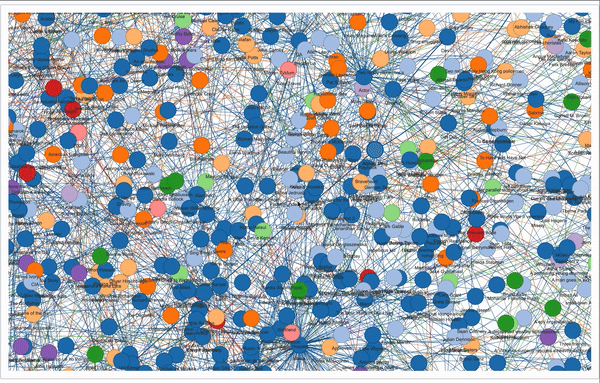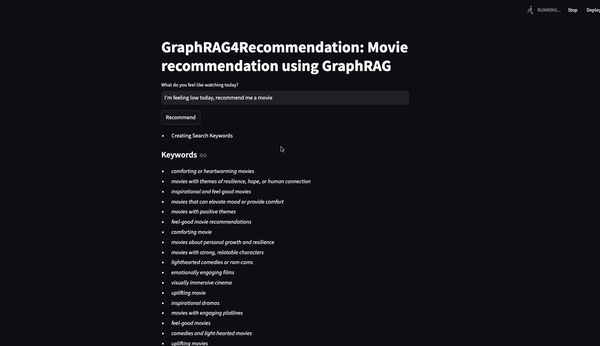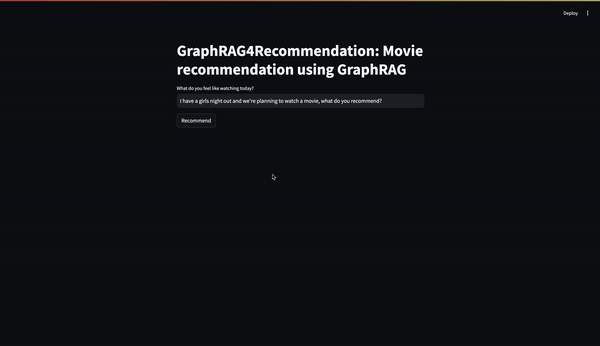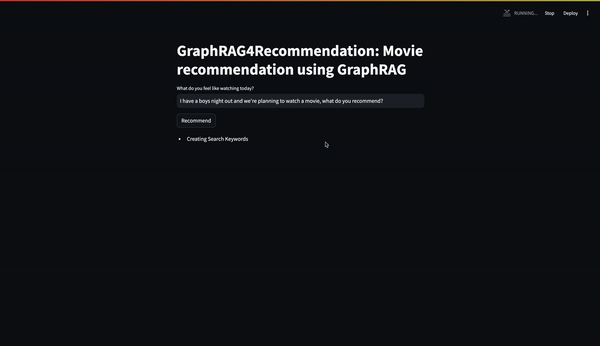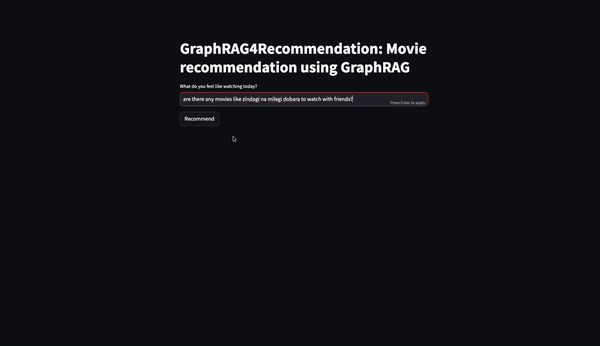GraphRAG for a movie recommendation system using OpenAI LLMs.
This repository contains a naive implementation of Microsoft's GraphRAG paper - From Local to Global: A Graph RAG Approach to Query-Focused Summarization.
Note: The implementation doesn't entrirely copy everything that's described in the paper or their code repository.
This implementation borrows inspiration (mostly prompts) from the paper and the graphrag codebase and applies it in the field of recommendation systems.
This is more like "Graph-Enhanced Content-Based Recommendation System with RAG Capabilities."
git clone https://github.com/vatsalsaglani/GraphRAG4Rec.gitcd GraphRAG4RecThis project uses Poetry for dependency management. If you don't have Poetry installed please follow this documentation.
poetry installCreate a .env file and add your OpenAI API key.
OPENAI_API_KEY="YOUR_OPEN_API_KEY"This project comes with the IMDB Top 1000 Movies dataset source from Kaggle.
Using this dataset we will create the graph and detect communities.
Note: From here on, run all the commands from inside the
srcfolder.cd src/
Run the following command.
poetry run python -m graphragrec.graph.graphThis command will run the graph module which will do the following,
- Extract Entities
- Create Relations
- Extract Claims from Entities + Relations
- Builds and Visualizes the Graph
- Detects Communities and Visualizes those
- Also saves the graph data (entities, relations, claims), graph, and the communities.
It will create a folder src/output/v7-all where it will save everything.
To see the graph and the communities a live-server using the VSCode Live-Server extension.
The following is how the graph with communities will look like.
There are 100 communities in total with a lot of nodes and relations. Hence, it might take time to load as well.
Note: We're using
gpt-3.5-turbo-0125for these tasks and it can take an hour to fetch entities, relations, and claims for every movies. After which the graphs will be built. It will cost around $3 to $5.
Once the community graph is created we need to create summary reports for each community which will contain high-level information about what that community represents.
To do this run the following command.
poetry run python -m graphragrec.graph.communitiesThis command will fetch the graph and community stored in the last step at src/output/v7-all and use that to summarize the communities and create reports.
The communities with summary reports will be stored at src/output/v7-all/community-reports.json.
Note: We're using
gpt-3.5-turbo-0125for these tasks and it can take 30 to 40 minutes to summarize the communities.It will cost around $4 to $6.
To generate a response for a user query we need to pass that query to all the communities (worst case) which can be time taking because of multiple calls and expensive.
To avoid that we'll batch communities based on token lengths and max batch size to be
To batch run the following command.
poetry run python -m graphragrec.utils.helpers.batch_community_reportsThis command will run the batch_community_report module which will take the community reports from the src/output/v7-all/community-reports.json file and batch those programatically.
There are a lot of ways communities can be batched. One such was is during detection we find levels in the community hierarchy.
We're using the Leiden algorithm (as mentioned in the paper) to detect communities. After detection we can get the levels and batch communities as well.
In this codebase, a naive approach of batching is implemented. In total we'll have
The batches will be stored at src/output.v7-all/batched-community-reports.json.
The codebase contains a Streamlit application via which we can get recommendation.
Use the following command to run the Streamlit application.
poetry run streamlit run streamlit.pyThis will start the Streamlit application client and expose it on a port on your system and redirect you to a browser.
Enter the message in the input and get recommendation.
Head's Up: For recommendation we use the GPT-4o model. In every recommendation we'll have around
$90,000$ to$102,000$ input tokens (cummulative) and$8,000$ to$10,000$ output tokens (cummulative). Hence, recommendations are a costly affair.
The following is how the recommendations will look like.
